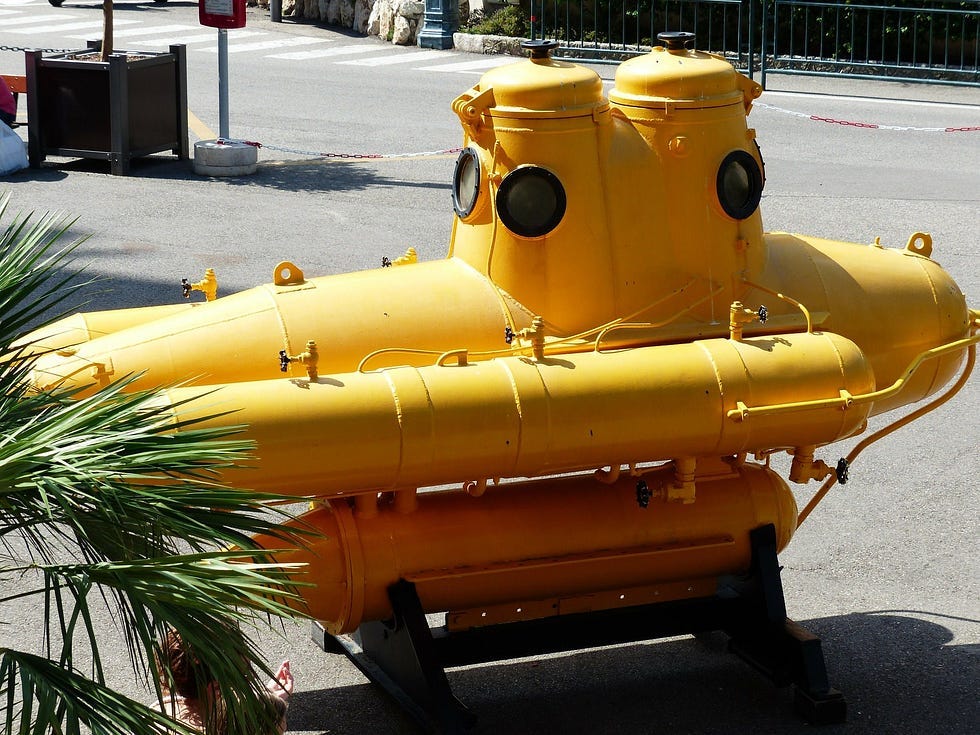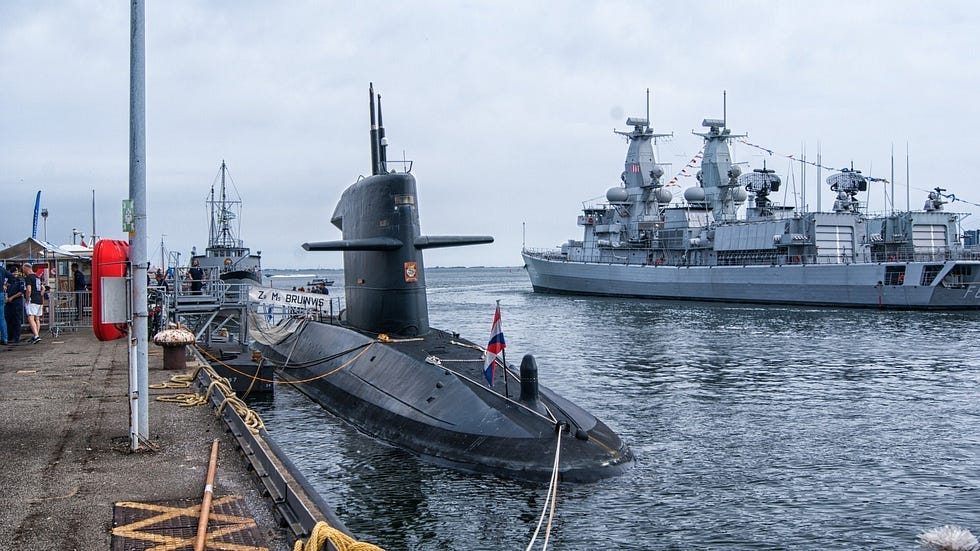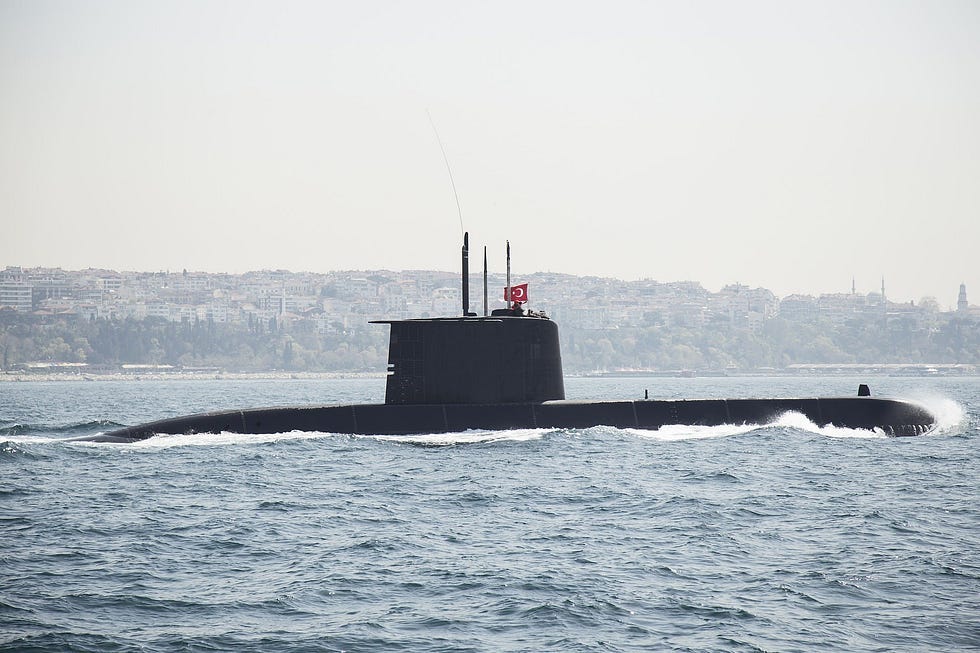That thing in the picture is a submarine, right? NO! It may surprise you to learn this, but that’s a different category of underwater vessel. I know what you’re thinking, “haven’t you written enough about marine engineering trivia?” The answer is no, there will never be enough.
THIS is a submarine. It’s a large craft with over a hundred crew, probably nuclear powered (but can be diesel electric, or even fuel cell powered). It has a long endurance at sea, up to three years for SSGNs. It operates independently and needs no surface support ship.
This is a submersible. It’s a small vessel, two seats in this case but some have as many as five. Tourist submersibles often have as many as thirty seats, but they are still submersibles, not submarines. Why is that? Size is not the only defining criteria.
A submarine has options for life support that a submersible does not. While some older diesel electric subs surfaced often enough to air out the interior, not requiring any actual life support machinery (beyond a circulation pump that operates when surfaced), nuclears subs perform hydrolysis.
This means they utilize the absurd abundance of electricity generated by the onboard reactor to split water into hydrogen and oxygen. The oxygen is used to replenish what is lost in the air, as the crew breathes. Desalination can also be performed onboard to provide fresh water, as well as electric heating.
Those are luxuries not available in submersibles, because they run entirely on batteries. Of course diesel electric submarines run on batteries while submerged, but they have diesel generators to recharge them with, a submersible does not. It relies on a surface support ship for long distance transport and charging.
Submarines, because of their abundance of onboard energy, can utilize methods of CO2 removal not possible for submersibles. Submersibles use a passive means of removing excess CO2 from the air, usually a sodalime powder like SodaSorb.
Nuclear submarines on the other hand can use amine, a CO2 absorbant which is reversible, so it can be reused. At room temperature, it absorbs CO2. But when heated up, it out-gasses, releasing the CO2. When it out-gasses, the CO2 is captured and ejected from the submarine into the surrounding water.
Compare this to how the ISS removes CO2. There is enough power from solar to perform hydrolysis of O2 out of water. However liquid amine is not used due to the high power requirements for thermally induced outgassing. Instead they must use consumable lithium hydroxide canisters to chemically remove CO2.
So, their system is halfway between what submarines use, and what submersibles use. In part because the power available to the ISS falls somewhere between those two. It is not ideal because the ISS cannot make replacement lithium hydroxide in situ, whereas liquid amine is reusable as a CO2 absorbant an indefinite number of times.
Of course, this is a solvable problem. Either increase the amount of solar generation capacity (and batteries) on the ISS to support the energy requirements of a nuclear submarine style CO2 removal system, or power it with a compact nuclear reactor.
Does it surprise you to learn that underwater vessels share so much in common, technologically, with spacecraft? It shouldn’t. The life support systems used in the Gemini missions, which predated the Apollo program, were adapted from systems used aboard submersibles of that period.
One withstands a single atmosphere of pressure difference from the inside, the other withstands multiple atmospheres of external pressure. One goes up, the other goes down. Besides that, the differences are trivial. Both must solve the same fundamental problems where life support is concerned.
How do you keep the air in an enclosed space breathable for long periods? How do you keep the occupants warm? What will they drink, how will they eliminate waste, where will they sleep, and so on. This overlap in engineering principles is why there’s such longstanding interest in sea/space analog missions like NEEMO.
The ocean in many respects is like a mirror, or twin, of space. Similar challenges are involved, and the primary difference between a submarine and submersible is how long either is able to overcome those challenges before requiring an influx of additional energy or other resources.
You might compare this, for example, to how a small spacecraft like the SpaceX Dragon capsule differs from a space station in terms of how long either is able to meet the survival needs of humans onboard. But I’ll leave that for a future article. :)
Citations:
https://ntrs.nasa.gov/archive/nasa/casi.ntrs.nasa.gov/20050210002.pdf
http://www.astronautix.com/g/geminitechnaldescription.html
https://pubs.acs.org/doi/abs/10.1021/ie4040658
http://www.dtic.mil/dtic/tr/fulltext/u2/461151.pdf
https://fau.digital.flvc.org/islandora/object/fau%3A2691/datastream/OBJ/view/Life_suppot_materials_in_a_manned_submersible.pdf
https://www.shearwater.com/wp-content/uploads/2012/08/Sodasorb_Manual.pdf
http://www.psubs.org/design/lifesupport/lifesupport.pdf












